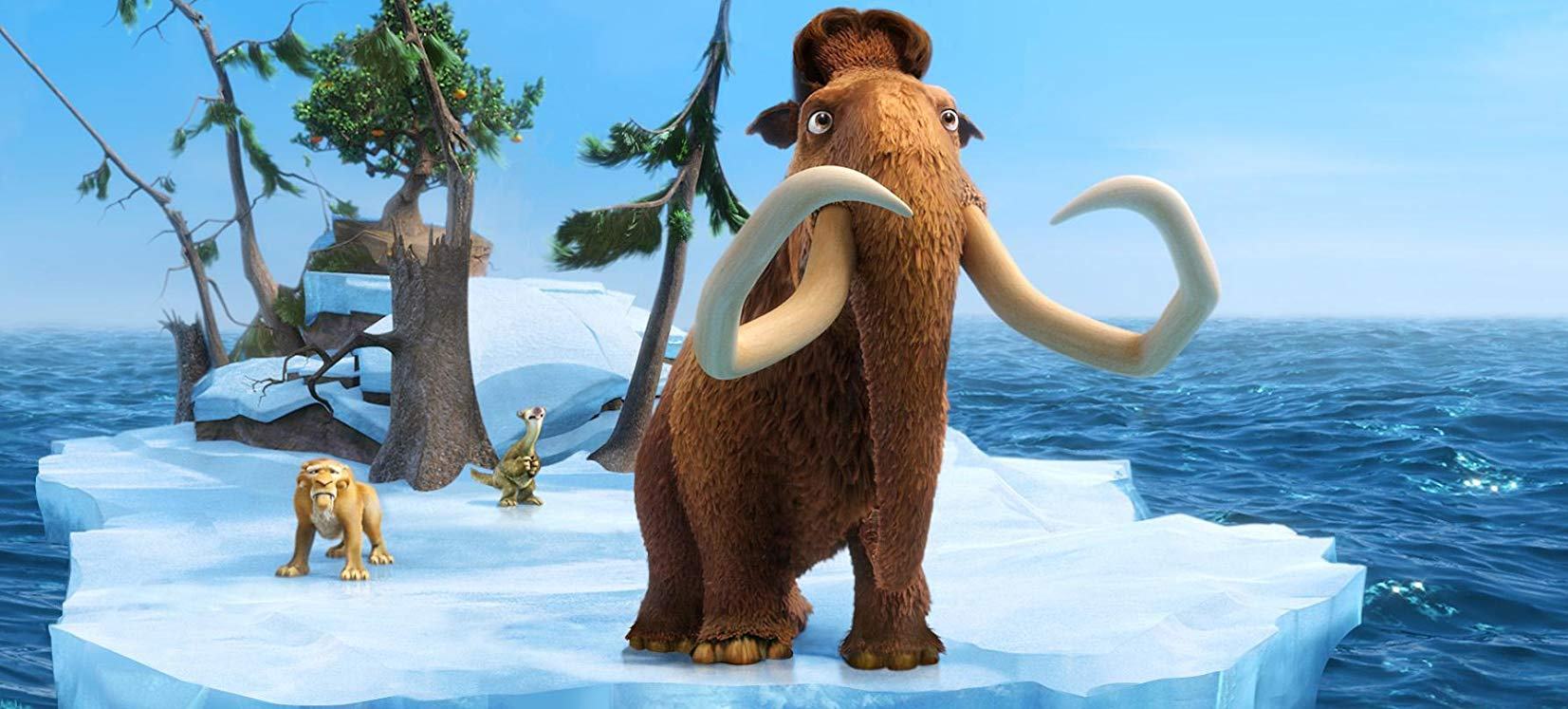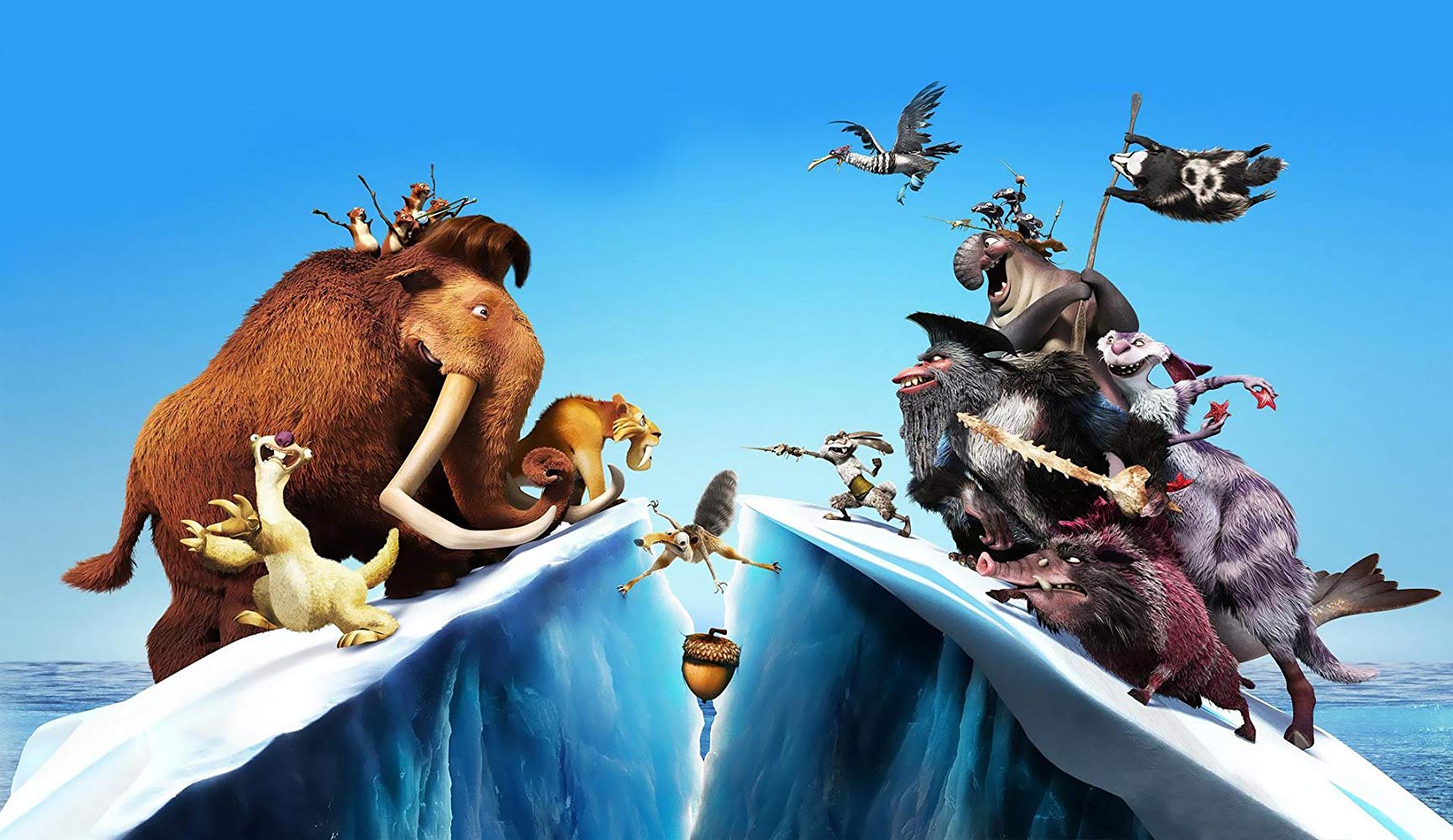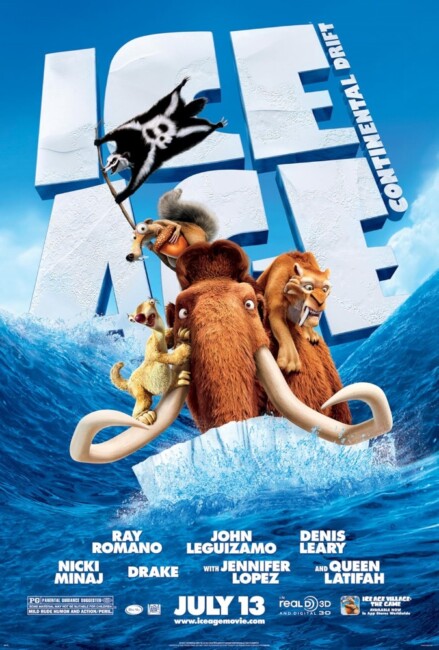USA. 2012.
Crew
Directors – Steve Martino & Michael Thurmeier, Screenplay – Michael Berg & Jason Fuchs, Producers – John C. Donkin & Lori Forte, Photography – Renato Falcao, Music – John Powell, Animation Supervisors – James Bresnahan & Nick Bruno, Art Direction – Nash Dunnigan. Production Company – Blue Sky Studios.
Voices
Ray Romano (Manny), John Leguizamo (Sid), Denis Leary (Diego), Peter Dinklage (Captain Gutt), Jennifer Lopez (Shira), Keke Palmer (Peaches), Wanda Sykes (Granny), Queen Latifah (Ellie), Drake (Ethan), Josh Gad (Louis), Aziz Ansari (Squint), Nick Frost (Flynn), Seann William Scott (Crash), Josh Peck (Eddie), Nicki Minaj (Steffie), Heather Morris (Katie), Ally Romano (Meghan), Chris Wedge (Scrat), Kunal Nayyar (Gupta), Alain Chabat (Silas)
Plot
In the perpetual search for his acorn, the squirrel Scrat accidentally causes the continents of the Earth to split apart. Meanwhile, Manny is disapproving as his growing daughter Peaches starts developing an interest in other mammoth boys. The earth tremors caused by the continental drift reach the valley and Manny, Sid, Diego and Sid’s 80 year-old grandmother are cast adrift on a shard of ice as it is split from the mainland. They then encounter the pirate crew of Captain Gutt who sail the seas aboard an iceberg. They make an escape along with Gutt’s second-in-command, the female sabretooth Shira to whom Diego forms an attraction. Landing ashore, they hatch a plan and steal the new ship that Gutt has built. Gutt swears revenge and sets out to get to their families before they make it back home.
Continental Divide was the fourth in the series of the Ice Age animated films from Blue Sky Studios. The series began with the popular hit of the amiable Ice Age (2002). Blue Sky have gone onto other works such as Robots (2005), Horton Hears a Who! (2008), Rio (2011), Epic (2013), The Peanuts Movie (2015), Ferdinand (2017) and Spies in Disguise (2019). In between this, they turned Ice Age into a cash cow and milked out four increasingly insipid sequels with Ice Age 2 (2006) and Ice Age 3: Dawn of the Dinosaurs (2009) and subsequent to this Ice Age: Collision Course (2016).
Bar a handful of exceptions, the animation sequel never existed before the late 1990s. It began when Disney spawned a great many sequels to their animated films both classic and modern with the likes of The Return of Jafar (1994), Pocahontas II: Journey to the New World (1998), The Lion King II: Simba’s Pride (1998), The Little Mermaid II: Return to the Sea (2000) and Lady and the Tramp II: Scamp’s Adventure (2001), among many others. Most of their were cheaply made, did little to tell new stories and were simply founded around recycling familiar characters. They were cynically designed to appeal to child audiences who enjoyed the original.
Come the 00s and the idea of the animated sequel has become ubiquitous. Ice Age: Continental Drift came out six weeks after Dreamworks’ Madagascar 3: Europe’s Most Wanted (2012) where both felt such interchangeable pieces of product in the advertising that you had to often focus to remember which characters belonged to which series and which featured which voice actors. Even the normally respectable Pixar started to jump aboard this bandwagon with the likes of Toy Story 3 (2010), Cars 2 (2011), Monsters University (2013) and Finding Dory (2016) – indeed, much of their protracted and difficult contractual negotiations with Disney were about who owned the rights to the characters so they could make sequels.

It seems that the focus of animation is now no longer simply telling a story like a fairytale that is self-contained and ends with happily ever after but on creating franchises with characters that can be spawned through successive sequels. Although none of these others franchises have done so to the mind-boggling extent that The Land Before Time (1988) has done where it has spawned twelve sequels to date.
This is largely the problem with Ice Age: Continental Divide. It has no purpose as a film. In fact, it is not even a film; it is a money-making machine in the guise of a film. It traipses out the familiar characters and puts them through almost identical paces as before – about the only real difference here is that Manny is now an overly concerned parent of a teenager, Diego gets a love interest and Sid a cantankerous grandmother.
It is slickly made and makes a pitch at all opportunities for light comedy, slapstick and one-liners that play off pop culture familiarity – not to mention visual sequences that have been deliberately contrived for how they look in 3D. The characters never do anything so much as pass through well-oiled and overly familiar routines – the character of Scrat, a scene-stealer and audience favourite in the other films, has well and truly worn out his welcome by the point of this film. The scene at the end where he arrives at Scratlantis and pulls the plug that sinks the island is incredibly lame, while the sequence where he kicks off the continental drift seems to be straining to find the same visual humour the character had in the other films.
The difficulty in stretching the Ice Age series to a fourth entry is surely demonstrated in the absurdity of the title. The prehistoric era seems limited in terms of storytelling possibilities. Indeed, the premise about the animals having to evacuate their valley and/or find a new home is one that has been tried by every prehistoric animated film from Dinosaur (2000) to Ice Age 2, The Land Before Time and about every second one of its sequels. Without much in the way of familiar modern referents to play off, the writers seemed desperate to find something to get a handle on to tell a story. Ice Age 3 introduced the dinosaurs, this film turns to the theory of continental drift.

The problem with this is that Blue Sky seem to conveniently sweep under the carpet that such events are millions of years apart – continental drift began to occur 200 million years ago during the Mesozoic era when dinosaurs were still dominant on the Earth and the earliest mammals were only beginning to make an appearance, while most of the current continental formations were arrived at between 100-50 million years ago; Ice Age 3 featured dinosaurs, whose latest point on Earth came 64 million years ago; while the presence of mammals such as the sabre-tooth and mammoths, as well as the period of the ice age, puts the timeframe in which the films occur a mere 2.5 million years ago at the outside.
The thinking seems to be the same attitude to history as in the tv series Hercules: The Legendary Journeys (1994-9) – wherein events and people that were often thousands of years apart were constantly encountered – that prehistory is this giant place where events happen simultaneously and can be anachronistically rearranged for storytelling convenience.
Of equal absurdity is the idea of prehistoric pirates – as ships have not yet been discovered, the film improbably has pirates floating around conducting raids aboard icebergs (although in a period when no mammals had built ships, you keep wondering who there would be on the seas for them to raid). The idea seems to have been someone’s desire to add pirates to the film, even a film that didn’t need them, as well as create a traditional black hat villain for the series (which has been notably lacking up until now). At least, Peter Dinklage delivers a scene-stealing voice turn in the role of the pirate captain.
Trailer here


